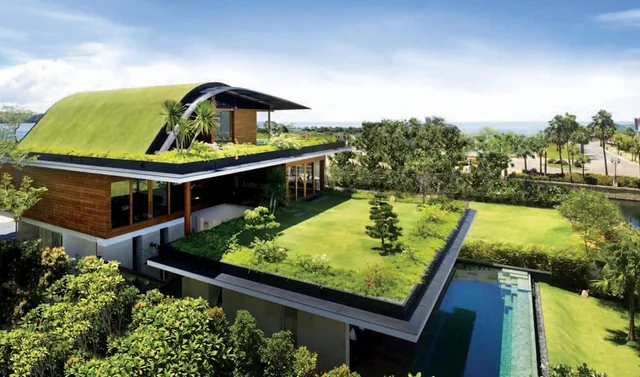In today’s world, environmental sustainability is no longer a luxury or a secondary consideration, but a crucial necessity for the long-term health of our planet. As concerns over climate change, resource depletion, and ecological degradation grow, industries across the globe are seeking ways to minimize their environmental impact. One of the most powerful ways to achieve this goal is through architecture. Architecture can play a significant role in advancing environmental sustainability by integrating eco-friendly practices, utilizing green materials, and reducing the carbon footprint of buildings.
Architecture has the unique ability to shape our built environment and influence how we interact with the natural world. In this article, we will explore the various ways architecture contributes to environmental sustainability, the principles behind sustainable architecture, and how both designers and inhabitants can work together to create a more sustainable future.
1. The Role of Architecture in Environmental Sustainability
Architecture, in its most sustainable form, aims to minimize negative impacts on the environment while providing functional, aesthetically pleasing, and comfortable spaces for people. Sustainable architecture focuses on reducing energy consumption, utilizing renewable resources, minimizing waste, and promoting healthier environments for both people and the planet.
a) Energy Efficiency
Energy efficiency is one of the key pillars of sustainable architecture. Buildings consume a significant amount of energy for heating, cooling, lighting, and other operational needs. Architects can mitigate this by designing energy-efficient buildings that reduce energy demand, lower greenhouse gas emissions, and minimize the overall environmental impact.
Passive Design
One of the most effective strategies for improving energy efficiency is through passive design. Passive design relies on the building’s layout, orientation, and the use of natural materials to reduce energy use. For example, positioning a building to maximize natural sunlight can reduce the need for artificial lighting, while proper insulation helps maintain a comfortable indoor temperature without excessive heating or cooling.
- Orientation and Solar Gain: By positioning windows and other openings to take advantage of the sun’s warmth in winter, a building can passively heat itself, reducing reliance on heating systems. In the summer, carefully placed overhangs or shading devices can prevent overheating.
- Natural Ventilation: Designing buildings to allow for natural airflow reduces the need for air conditioning, saving energy. Cross-ventilation systems can improve air quality while reducing reliance on mechanical systems.
- Insulation and High-Performance Windows: High-performance windows and effective insulation materials can prevent heat loss during colder months and minimize heat gain in warmer months, contributing to the overall efficiency of the building.
b) Sustainable Materials
The materials used in construction have a significant impact on the environment. Sustainable architecture prioritizes materials that are renewable, energy-efficient, and have a minimal environmental footprint.
Locally Sourced Materials
Using locally sourced materials reduces transportation costs and associated carbon emissions. It also helps to support local economies and ensures that materials are adapted to the regional climate. For instance, using bamboo, which grows rapidly and can be replenished quickly, is a sustainable material choice for many types of construction.
Recycled and Reusable Materials
Another effective way to minimize waste in architecture is through the use of recycled and repurposed materials. Recycled steel, glass, and plastic can be used in construction, preventing these materials from ending up in landfills. Additionally, some buildings are designed to be disassembled, and their components can be reused in future construction projects, reducing the need for virgin materials.
Low-Impact and Non-Toxic Materials
Choosing materials that are low-impact and non-toxic is an essential aspect of sustainable architecture. Materials that release harmful chemicals or require large amounts of energy to produce can be harmful to both the environment and the occupants of the building. Sustainable alternatives include natural stone, wood certified by organizations like the Forest Stewardship Council (FSC), and low-VOC (volatile organic compound) paints and finishes.
c) Water Conservation
Water scarcity is a growing issue in many parts of the world, and buildings consume a substantial amount of water for activities such as irrigation, washing, and sanitation. Sustainable architecture works to reduce water consumption by incorporating systems and designs that promote water efficiency.
Rainwater Harvesting
Rainwater harvesting is a sustainable method of collecting and storing rainwater for later use. This water can be used for non-potable purposes, such as irrigation, flushing toilets, or cleaning. By collecting and using rainwater, buildings reduce the demand on municipal water supplies and help conserve this vital resource.
Water-Efficient Fixtures
Installing water-efficient fixtures like low-flow toilets, faucets, and showerheads helps to reduce water usage without sacrificing comfort or functionality. These fixtures limit the amount of water used in everyday activities, contributing to long-term water conservation efforts.
Greywater Recycling
Greywater is wastewater generated from activities like showering, washing hands, and doing laundry. It can be filtered and treated for reuse in irrigation or flushing toilets, reducing the need for potable water and contributing to more sustainable water management.
d) Renewable Energy Integration
Buildings are responsible for a large portion of global energy consumption, and one way architecture contributes to sustainability is by integrating renewable energy sources, such as solar, wind, and geothermal systems.
Solar Panels
Solar panels are one of the most widely used renewable energy technologies in sustainable architecture. They convert sunlight into electricity, providing a clean energy source for buildings. By incorporating solar panels into the design, architects can reduce a building’s reliance on fossil fuels and minimize its carbon footprint.
Wind Energy
In certain locations, integrating wind turbines into a building’s design can also help generate clean energy. Wind energy is particularly effective in areas with strong, consistent winds. Like solar panels, wind turbines can be used to offset energy demands and contribute to a building’s sustainability.
Geothermal Systems
Geothermal energy uses the constant temperature of the earth to provide heating and cooling. Geothermal heat pumps can be integrated into building designs to offer an energy-efficient and sustainable way to regulate indoor temperatures, reducing the need for traditional heating and air conditioning systems.
e) Waste Reduction and Sustainable Building Practices
Sustainable architecture also focuses on reducing waste during both the construction phase and the life cycle of the building.
Construction Waste Management
Building projects often generate significant waste, including excess materials, packaging, and debris. A sustainable approach to construction involves minimizing waste through careful planning, reusing materials, and recycling whenever possible. In some cases, entire buildings are deconstructed and their materials reused for new projects, further reducing waste.
Design for Disassembly
Some buildings are designed with the end in mind. This means that structures are constructed with the ability to be easily disassembled at the end of their life cycle. This approach allows for the reuse of materials and components in future construction, reducing the demand for new resources.
f) Green Roofs and Urban Green Spaces
In urban areas, the introduction of green roofs and urban green spaces can have a significant impact on sustainability. Green roofs, which are covered in vegetation, can help reduce a building’s energy consumption by providing natural insulation and reducing the heat island effect. Additionally, they improve air quality, reduce stormwater runoff, and create more pleasant environments for residents and workers.
Urban green spaces, such as parks and community gardens, can contribute to biodiversity, provide recreational areas, and help mitigate the environmental effects of dense urbanization.
g) Smart Technology and Building Automation
Technology can be integrated into buildings to help monitor and control energy usage more effectively. Smart systems can adjust lighting, temperature, and ventilation based on real-time conditions, optimizing energy consumption and improving efficiency.
For example, smart thermostats adjust heating and cooling systems based on occupancy patterns, while lighting systems can turn off automatically when no one is present. These technologies not only make buildings more comfortable but also help reduce energy consumption and lower operating costs.
2. The Benefits of Sustainable Architecture
The adoption of sustainable architecture practices offers several key benefits:
- Environmental Impact: Sustainable buildings reduce greenhouse gas emissions, conserve natural resources, and minimize waste. By using energy-efficient technologies and renewable resources, sustainable architecture helps protect the planet.
- Economic Advantages: While the upfront costs of sustainable architecture may be higher, energy-efficient buildings result in lower operational costs over time. Reduced utility bills and tax incentives for using renewable energy or sustainable materials can make green buildings more economically viable.
- Health and Well-being: Sustainable architecture often emphasizes natural lighting, clean air, and comfortable living spaces, which can improve the physical and mental well-being of occupants. Additionally, non-toxic materials create healthier indoor environments.
- Long-Term Viability: Sustainable buildings are built with resilience in mind, using durable, renewable materials that can withstand the test of time. As the world faces increasing environmental challenges, these buildings are better equipped to adapt to changing conditions.
Frequently Asked Questions (FAQs)
1. What is sustainable architecture?
Sustainable architecture is the practice of designing buildings that minimize their environmental impact by using energy-efficient technologies, sustainable materials, and resource-saving strategies like water conservation and renewable energy integration.
2. How can energy efficiency be achieved in architecture?
Energy efficiency can be achieved through passive design strategies, such as optimal building orientation, insulation, natural ventilation, and the use of high-performance windows. Additionally, renewable energy sources like solar panels and wind turbines can help reduce a building’s energy demand.
3. What are some examples of sustainable building materials?
Examples of sustainable materials include bamboo, recycled steel, reclaimed wood, and low-VOC paints and finishes. Locally sourced materials and natural stone are also commonly used in sustainable architecture.
4. How do green roofs contribute to sustainability?
Green roofs provide insulation, reduce the urban heat island effect, improve air quality, and manage stormwater runoff. They also create green spaces in urban areas, promoting biodiversity and improving the quality of life for inhabitants.
5. What is the role of technology in sustainable architecture?
Technology, such as smart building systems, can help optimize energy use, control lighting and temperature, and reduce operational costs. Smart thermostats, automated lighting, and energy monitoring systems are commonly used in sustainable buildings.
6. How can architecture contribute to water conservation?
Sustainable architecture incorporates systems like rainwater harvesting, greywater recycling, and water-efficient fixtures to reduce water consumption. These strategies help conserve this valuable resource and reduce reliance on municipal water systems.
7. Why is sustainable architecture important for future generations?
Sustainable architecture helps mitigate climate change, conserves natural resources, and improves living conditions. By prioritizing the health of the environment, sustainable buildings ensure a better quality of life for future generations.
Conclusion
Architecture is a powerful tool in the fight for environmental sustainability. By prioritizing energy efficiency, sustainable materials, water conservation, and renewable energy, architects can create buildings that not only serve the needs of their occupants but also protect and preserve the environment. Sustainable architecture benefits everyone – from the planet to the people who live in and work within these spaces.
Key Takeaways
- Energy Efficiency: Passive design, proper insulation, and natural ventilation can reduce a building’s energy demand.
- Sustainable Materials: Using locally sourced, recycled, and non-toxic materials minimizes environmental impact.
- Water Conservation: Rainwater harvesting, greywater recycling, and water-efficient fixtures help conserve water.
- Renewable Energy: Solar panels, wind turbines, and geothermal systems can reduce reliance on fossil fuels.
- Technological Integration: Smart building systems optimize energy consumption and improve efficiency.
- Green Roofs and Urban Green Spaces: Green roofs and urban parks contribute to environmental health, reduce heat, and improve air quality.
- Long-Term Benefits: Sustainable architecture results in long-term environmental, economic, and health benefits.
As the world continues to face environmental challenges, architecture offers a viable and impactful solution for creating more sustainable, resilient, and healthy living spaces for future generations.

